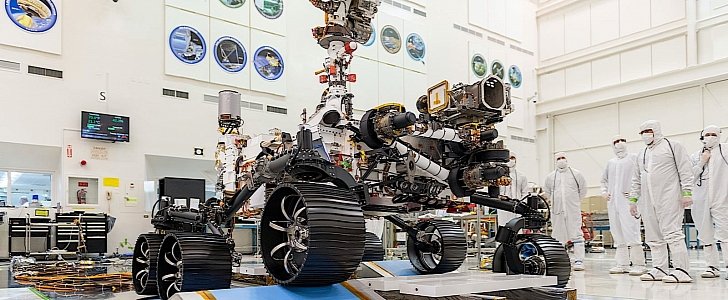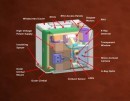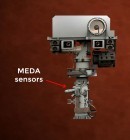Less than a year remains until the launch of the most important Mars mission to date. In July or August 2020, an Atlas V rocket will be taking its payload beyond the confines of Earth’s gravity, and shoot it on to Mars. Its cargo: the newest exploration rover.
For now called only Mars 2020, the rover is already fully assembled and this week NASA said it even has been put through its paces and conducted its first-ever test drive.
The test took place indoors, in a cleanroom at the Jet Propulsion Laboratory in Pasadena, California. These are not exactly the conditions the rover will have to face on Mars, but the test was needed to show all the components work as they should.
According to NASA, the test took some 10 hours (compressed in under a minute in the video attached below) and called for the rover to drive, steer, turn and climb over ramps. At the end of the test, engineers found the rover “checked all the necessary boxes.”
The feat is impressive, given the fact the test was done under more severe gravity conditions than what the machine will be subjected to on Mars. There, the planet’s pull is three-eighths as strong, and the rover should work even better.
This piece of hardware will be the most autonomous of its class ever sent to another planet. It will be capable of making more driving decision on its own, based on data it receives from wide-field-of-view color navigation cameras, and an extra computer.
Once on site, the rover is expected to cover 650 feet (200 meters) per Martian day, for a total that would “average the current planetwide record drive distance.”
The new rover is based on the same platform as the Curiosity and measures 10 feet long (3 meters), 9 feet wide (2.7 meters), and 7 feet tall (2.2 meters). It has six wheels, a body that hides computers and other hardware, and a power source that runs on plutonium-238.
Seven state-of-the-art tools and instruments are to be used to look for signs of life, assess the habitability of the environment, track natural resources and hazards and even try to generate oxygen.
The test took place indoors, in a cleanroom at the Jet Propulsion Laboratory in Pasadena, California. These are not exactly the conditions the rover will have to face on Mars, but the test was needed to show all the components work as they should.
According to NASA, the test took some 10 hours (compressed in under a minute in the video attached below) and called for the rover to drive, steer, turn and climb over ramps. At the end of the test, engineers found the rover “checked all the necessary boxes.”
The feat is impressive, given the fact the test was done under more severe gravity conditions than what the machine will be subjected to on Mars. There, the planet’s pull is three-eighths as strong, and the rover should work even better.
This piece of hardware will be the most autonomous of its class ever sent to another planet. It will be capable of making more driving decision on its own, based on data it receives from wide-field-of-view color navigation cameras, and an extra computer.
Once on site, the rover is expected to cover 650 feet (200 meters) per Martian day, for a total that would “average the current planetwide record drive distance.”
The new rover is based on the same platform as the Curiosity and measures 10 feet long (3 meters), 9 feet wide (2.7 meters), and 7 feet tall (2.2 meters). It has six wheels, a body that hides computers and other hardware, and a power source that runs on plutonium-238.
Seven state-of-the-art tools and instruments are to be used to look for signs of life, assess the habitability of the environment, track natural resources and hazards and even try to generate oxygen.













